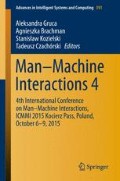Abstract
The aim of the paper is to discuss the problem of geospatial data integration for criminal analysis. In order to integrate and analyze various data sources the platform introduces an object-based data model for each analyzed domain. The paper focuses on the model for geospatial analysis and integration methods that allow to visualize and analyze various data on geographical map. To verify the realized concept, a simple case study is given as an example of the integration results.
Access this chapter
Tax calculation will be finalised at checkout
Purchases are for personal use only
Notes
- 1.
LINK Platform is developed at AGH-UST in Krakow as an environment for building software tools supporting polish criminal analysts. More about the platform can be found at https://www.fslab.agh.edu.pl/#!product/link2. LINK Map is a tool-set that provides graphical components for integration of geo-spatial data, their visualization, analytical tools and extensions for gathering data in various formats.
- 2.
References
Dębski, R., Kisiel-Dorohinicki, M., Młoś, T., Piętak, K.: Link: a decision-support system for criminal analysis. In: MCSS 2010. pp. 110–116. Krakow, Poland (2010)
Dajda, J., Debski, R., Kisiel-Dorohinicki, M., Pietak, K.: Multi-domain data integration for criminal intelligence. In: Gruca, A., Czachórski, T., Kozielski, S. (eds.) Man-Machine Interactions 3. AISC, vol. 242, pp. 345–352. Springer, Switzerland (2013)
Dijkstra, E.: A note on two problems in connexion with graphs. Numer. Math. 1(1), 269–271 (1959)
Gorr, W.L., Kurland, K.S.: GIS tutorial for crime analysis. Esri Press, New York (2011)
Haining, R.: Spatial data analysis: theory and practice. Cambridge University Press, Cambridge (2003)
IBM: IBM i2 Analyst’s Notebook website, www.ibm.com/software/products/en/analysts-notebook
Payne, J., Solomon, J., Sankar, R., McGrew, B.: Palantir: The future of analysis. In: VAST 2008, pp. 201–202. Columbus, USA (2008)
Rutkin, A.: Crime suspects in sicily traced by cellphone metadata. New Sci. 222(2966), 20 (2014)
Santos, R.: Crime modeling and mapping using geospatial technologies. SAGE Publications, Los Angeles (2012)
Saravanan, M., Thayyil, R., Narayanan, S.: Enabling real time crime intelligence using mobile gis and prediction methods. In: EISIC 2013, pp. 125–128. Uppsala, Sweden (2013)
Silverman, B.W.: Density estimation for statistics and data analysis. Chapman and Hall, New York (1986)
Smith, M., Longley, P., Goodchild, M.: Geospatial analysis: a comprehensive guide to principles. techniques and software tools. The Winchelsea Press, Leicester (2013)
Wang, X., Lin Liu, J.E.: Crime simulation using gis and artificial intelligent agents. In: Lin Liu, J.E. (ed.) Artificial Crime Analysis Systems, pp. 209–225. IGI GLOBAL, London (2008)
Acknowledgments
The research reported in the paper was partially supported by grants “Advanced IT techniques supporting data processing in criminal analysis” (No. 0008/R/ID1/2011/01) and “Information management and decision support system for the Government Protection Bureau” (No. DOBR-BIO4/060/13423/2013) from the Polish National Centre for Research and Development.
Author information
Authors and Affiliations
Corresponding author
Editor information
Editors and Affiliations
Rights and permissions
Copyright information
© 2016 Springer International Publishing Switzerland
About this paper
Cite this paper
Piętak, K., Dajda, J., Wysokiński, M., Idzik, M., Leśniak, Ł. (2016). Geospatial Data Integration for Criminal Analysis. In: Gruca, A., Brachman, A., Kozielski, S., Czachórski, T. (eds) Man–Machine Interactions 4. Advances in Intelligent Systems and Computing, vol 391. Springer, Cham. https://doi.org/10.1007/978-3-319-23437-3_39
Download citation
DOI: https://doi.org/10.1007/978-3-319-23437-3_39
Published:
Publisher Name: Springer, Cham
Print ISBN: 978-3-319-23436-6
Online ISBN: 978-3-319-23437-3
eBook Packages: EngineeringEngineering (R0)

